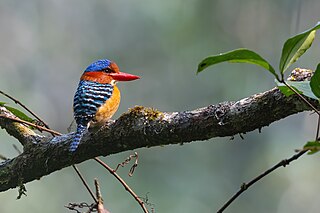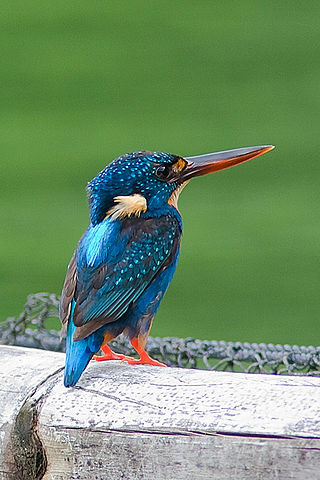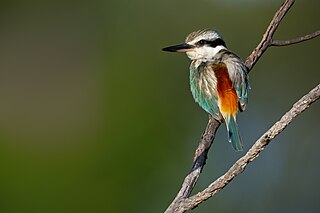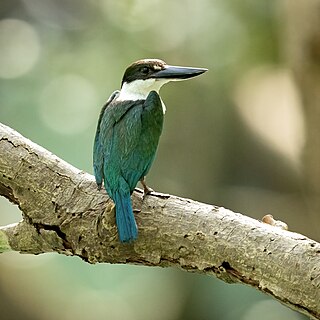
The sacred kingfisher is a medium-sized woodland kingfisher that occurs in mangroves, woodlands, forests and river valleys in Australia, New Zealand and other parts of the western Pacific.

Todiramphus is a genus of kingfishers in the subfamily Halcyoninae that are endemic to the Philippines, New Guinea, Australia, New Zealand and many islands in the South Pacific.

The yellow-billed kingfisher(Syma torotoro) is a medium-sized tree kingfisher.

The collared kingfisher is a medium-sized kingfisher belonging to the subfamily Halcyoninae, the tree kingfishers. It is also known as the white-collared kingfisher, black-masked kingfisher or mangrove kingfisher. It has a wide range extending from the Red Sea across southern Asia to Polynesia. A number of subspecies and subspecies groups have been split from this species including the Pacific kingfisher, the islet kingfisher, the Torresian kingfisher, the Mariana kingfisher, and the Melanesian kingfisher.

The banded kingfisher is a tree kingfisher found in lowland tropical forests of southeast Asia. It is the only member of the genus Lacedo. Male and female adults are very different in plumage. The male has a bright blue crown with black and blue banding on the back. The female has rufous and black banding on the head and upperparts.

The moustached kingfisher, also called Bougainville moustached kingfisher, is a species of bird in the family Alcedinidae. It is endemic to Bougainville Island in Papua New Guinea. An estimated 250–1,000 mature individuals are left.

The rufous-collared kingfisher is a species of bird in the family Alcedinidae. It is found in Brunei, Indonesia, Malaysia, Myanmar, and Thailand. Its natural habitats are subtropical or tropical moist lowland forest and subtropical or tropical moist montane forest. It is threatened by habitat loss.

The Indigo-banded kingfisher is a species of bird in the family Alcedinidae. It is endemic to the Philippines, where it is generally uncommon but locally widespread in the northern and central islands.

The Moluccan dwarf kingfisher, formerly known as the variable dwarf kingfisher, is a species of bird in the family Alcedinidae.

The mountain kingfisher is a species of bird in the subfamily Halcyoninae in the family Alcedinidae. Adult males are 21–24 cm (8.3–9.4 in) long, and have a rufous head and underparts, greenish-blue upperparts, a dark blue tail, and black flight feathers. They also have dark neck patches and loral patches. Females have dark crowns and the neck patches join at the nape. It is similar to the yellow-billed kingfisher, but can be distinguished by its larger size and a proportionally larger bill, along with a dark ridge along its culmen.

The cinnamon-banded kingfisher is a species of bird in the family Alcedinidae. It is found in Indonesia and East Timor. It is endemic to the Lesser Sundas. Its natural habitat is subtropical or tropical dry forests. It is threatened by habitat loss.

The blue-black kingfisher is a species of bird in the family Alcedinidae.A medium-sized kingfisher of mangroves and forested streams in the lowlands. It is found in New Guinea and offshore islands of Salawati, Batanta and Yapen. It is considered rare and declining with threats being logging of lowland swamp forests and declining water quality.

The red-backed kingfisher is a species of kingfisher in the subfamily Halcyoninae, also known as tree kingfishers. It is a predominantly blue-green and white bird with a chestnut rump. It is found across the continent of Australia, mainly inhabiting the drier regions.

The beach kingfisher is a species of bird in the family Alcedinidae. It is found in Indonesia, Papua New Guinea, and Solomon Islands. Its natural habitat is subtropical or tropical mangrove forests.

Winchell's kingfisher or the rufous-lored kingfisher, is a species of bird in the family Alcedinidae, the kingfishers. It is endemic to the Philippines, its natural habitat being lowland forests. It is threatened by deforestation, and the International Union for Conservation of Nature (IUCN) has assessed it as a vulnerable species.

The white-throated gerygone is a species of bird in the family Acanthizidae. It is found in Australia and Papua New Guinea. Its natural habitats are temperate forests and subtropical or tropical moist lowland forests. Its common names include white-throated warbler, white-throated flyeater, bush canary, and native canary.

The slaty robin, also known as the blue-grey robin, is a species of bird in the family Petroicidae, present in the New Guinea Highlands and sparsely in the island's northern areas. Its natural habitat is subtropical or tropical moist montane forests.

The white-bellied thicket fantail is a species of bird in the family Rhipiduridae. This species is one of 47 in the genus Rhipidura. It is found in New Guinea. Its natural habitats are subtropical or tropical moist lowland forests and subtropical or tropical mangrove forests.

The large-billed scrubwren is a passerine bird in the family Acanthizidae, endemic to eastern Australia. It is found in denser undergrowth in temperate forest, subtropical or tropical moist lowland forest, and subtropical or tropical moist montane forest.

The Torresian kingfisher is a species of bird in the family Alcedinidae. It is found in southern New Guinea and in Australia. Its natural habitats are subtropical or tropical moist lowland forests, mangroves, and plantations. It was formerly considered a subspecies of the collared kingfisher.






















